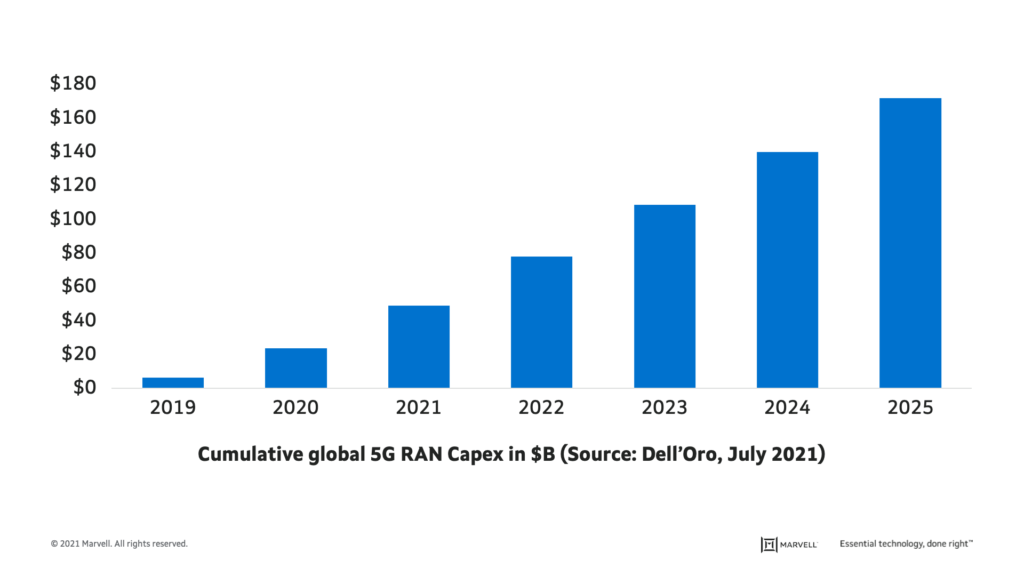

By Loi Nguyen, Executive Vice President, Cloud Optics Business Group, Marvell
Some twenty years ago the concept of IP over Wavelength Division Multiplexing (WDM) was proposed as a way to simplify the optical infrastructures. In this vision, all optical networks are connected via point-to-point mesh networks with a router at the center. The concept was elegant, but never took off because the optical technology at the time was not able to keep up with the faster innovation cycle of CMOS, driven by Moore’s law. The larger form factor of WDM optics does not allow them to be directly plugged into a router port. Adopting a larger form factor on the router in order to implement IP over WDM in a massive scale would be prohibitively expensive.
For routers to interface with the networks, a “transponder” is needed, which is connected to a router via short-reach optics on one side and WDM optics to the network on the other. The market for transponders grew quickly to become a multi-billion-dollar market.
A Star is Born
About 10 years ago, I was building a team at Inphi, where I was a co-founder, to further develop a nascent technology called silicon photonics. SiPho, as it’s called, leverages commercial CMOS foundries to develop photonics integrated circuits (PIC) that integrate hundreds of components ranging from high-speed modulators and detectors to passive devices such as couplers, waveguides, monitoring diodes, attenuators and so on. We were looking for ideas and customers to bring silicon photonics to the marketplace.
Fortunately, good technology and market need found one another. A group of Microsoft executives had been considering IP over WDM to launch a new concept of “distributed data centers,” in which multiple data centers in a region are connected by high speed WDM optics using the same form factor as shorter reach “client optics” used in switches and routers. By chance, we met at ECOC 2013 in London for the initial discussion, and then some months later, a product that enabled IP over WDM at cloud scale was born.
By Matt Bolig, Director, Product Marketing, Networking Interconnect, Marvell
There’s been a lot written about 5G wireless networks in recent years. It’s easy to see why; 5G technology supports game-changing applications like autonomous driving and smart city infrastructure. Infrastructure investment in bringing this new reality to fruition will take many years and 100’s of billions of dollars globally, as figure 1 below illustrates.
Figure 1: Cumulative Global 5G RAN Capex in $B (source: Dell’Oro, July 2021)
When considering where capital is invested in 5G, one underappreciated aspect is just how much wired infrastructure is required to move massive amounts of data through these wireless networks.
By Rohan Gandhi, Product Marketing Manager, Optical and Copper Connectivity
When the London Underground opened its first line in 1863, a group of doubtful dignitaries boarded a lurching, smoke-belching train for history’s inaugural subway ride. The next day, thirty thousand curious Londoners flooded the nascent system, and within a year, more than nine million had embraced its use. Nearly 160 years later, that original tunnel is still in daily use, joining 250 miles of track that carry more than 1.3 billion passengers annually.
What were the keys to such extraordinary growth? Not just popular demand for more tunnels, but also better use of accumulated infrastructure – optimized through newer trains, enhanced signaling, greater energy efficiency, and smarter scheduling. In a sense, the Tube’s transformation mirrors the fundamental challenge now confronting modern data centers: how to make better use of existing infrastructure to handle today’s exponential growth of data.
PAM4 DSP Technology is Fast and Flexible
To keep up with the surging data demands of new video and AI workloads, modern data centers can’t simply add more and bigger pipes – at least not cost-effectively. They need PAM4 based optical module solutions to effectively and efficiently move more bandwidth at higher speeds. In addition, they need to be able to update the optical modules via software, optimizing existing infrastructure at an affordable price.
Copyright © 2025 Marvell, All rights reserved.
